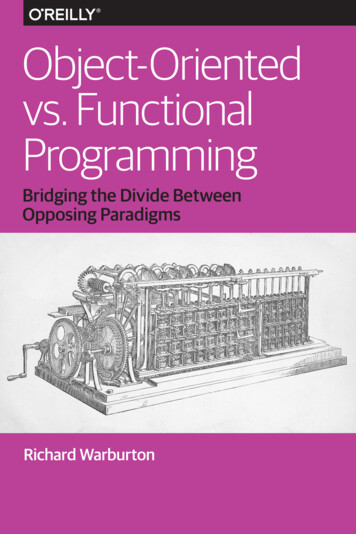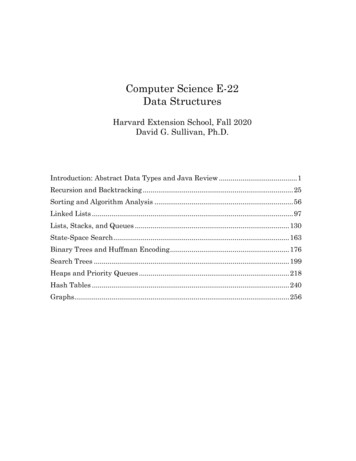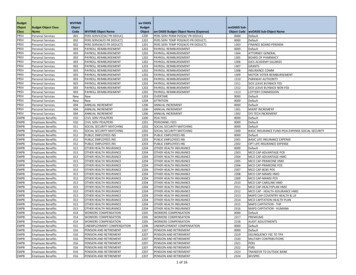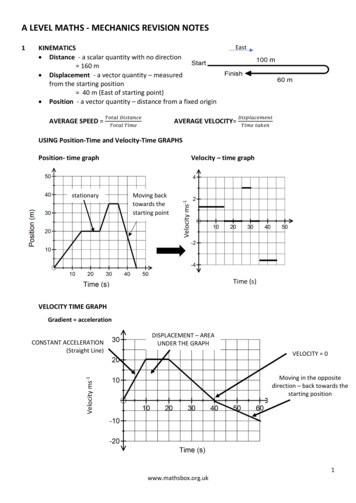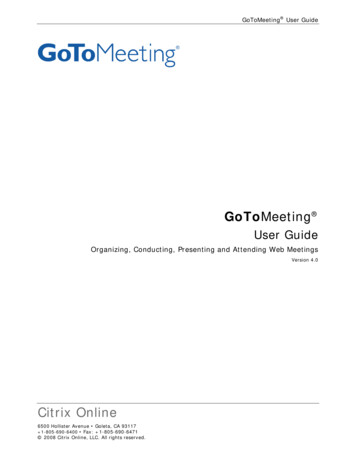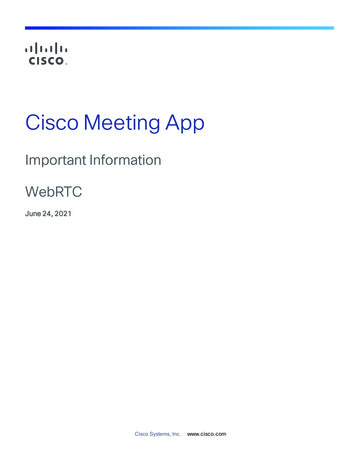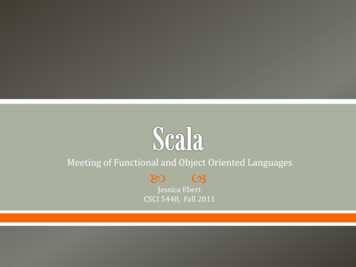
Transcription
Meeting of Functional and Object Oriented Languages Jessica EbertCSCI 5448, Fall 2011
Scala is a hybrid language that uses ideas from both thefunctional and object oriented programming ideasIt arises from the intention of creating a programming languagethat removed a lot of the hassle from Java and was user friendlyThe mantra of Scala is to create highly modular elements of aprogramo There are very few hard-written links or references to other objects orinstances in Scala. Most modules can be easily ported to be reused. Scala was runs using the Java Virtual Machine and is compatiblewith every Java library.Its relation to Java makes it very easy to switch to.Scala is not just an academic language, but has made impressiveinroads into the corporate world.
Scala was designed and named from the idea that a programshould contain components that are reusable and be easilyscalable.o The need for reusable and scalable is some of the main rational foradding the functional language elements Scala’s feature’s are generally directed for the creation ofmodular programs.o Minimizes hard links to specific componentso Allows for abstraction over the required support and services required. One of the key notions of Scala is “immutability first”o Having immutable code makes it much easier to create modular code.
Scala is a hybrid languageCombines object-oriented and functional programmingo Blends both worlds seamlesslyo Enables the programmer to use the Java open-source availabilityo Uses the principles from Haskell and ML for functionalprogrammingJavaScalaMLHaskell
Designed in 2001 by Martin Oderskyo Along with his group at ÉCOLE POLYTECHNIQUE FÉDÉRALE DELAUSANNE (EPFL) Odersky worked on programming language fundamentalsand became fascinated with the idea of simplifying andimproving Java.In 1995 he worked with Philip Wadler to write a functionallanguage that compiled to Java Bytecodes,o This was called Pizza. Next he developed GJ, a new javac compiler, then JavaGenerics.He designed Scala with the idea of making a user friendlylanguage that combined functional and Object orientedprogramming that eliminated the restrictions in Java.Scala was first publicly released in 2003, since then it hasbeen fully supported and gaining popularity(Scala, 2008)
Anything that looks like a language level keyword fornearly any object oriented language is probably defined inthe library.Because Scala compiles to Java bytecode, it enables you touse the plentiful Java resources.o You can even use the libraries that are available for Java The Java bytecode basis has an ever further benefit, it canbe almost seamlessly integrated with any system that canbe with Java.
module Main whereimport System.Environmentfibo 1 : 1 : zipWith ( ) fibo (tail fibo)main doargs - getArgsprint (fibo !! (read(args!!0)-1))
public class Fibonacci {public static long fib(int n) {if (n 1) return n;else return fib(n-1) fib(n-2); }public static void main(String[] args) {int N Integer.parseInt(args[0]);for (int i 1; i N; i ) System.out.println(i ": " fib(i));}}
import scala.math.BigIntlazy val fibs: Stream[BigInt] BigInt(0) #::BigInt(1) #::fibs.zip(fibs.tail).map { n n. 1 n. 2 }o While Scala infers types, this recursive value needs to be defined sothat Scala knows to run it on a stream and not another unrelated type.o The #:: is searched by Scala to find a conversion type that has the #::command This is why Stream was defined earlier, so that Scala knew to find aconversion type that had the method. Similarly to java, there is the standard main argumento The ability to infer a conversion type is one of the best features ofScala. However, it can be dangerous too.
object HelloWorld {def main(args: Array[String]) {println("Hello, world!")}} It is not necessary to declare a return type, even if this were toreturn somethingo The last line of an application, if it is a value, is assumed to be the returnobject.o Scala can also return methods and functions The main method is not declared as static because there are nostatic fields or methods.o Instead they are declared as singleton objects. The class, unlike Java, is declared as an object.o Scala is a pure-object oriented language because everything is an object.o This enables the programmer to manipulate functions as a value.
Singleton objecto A class with a single instanceo This declares both a class and an instance at once without having toinstantiate it. Limitationso A new instance of a singleton object can not be created. However, a class of the same name may be created that allows for thecreation of and the compiler will deduce that the class is being called. This will allow you to create a regular object of the same type, dependingon how the instance in the class is setup. Static methods or fields do not exist in Scala.
Functions are treated as objects in Scalao This is also known as First-Class functions. These functions have the literal syntax of an object.Because functions are objects, it opens up a world ofpossibilities.Functions can be passed as argumentso Stored as variableso Be returned from other functions This ability is the cornerstone of functional programmingand one of the main demonstrations of Scala’s dual nature.
There are classes in Scala, not just objects.They differ a bit from Java’s classes, although they aredeclared similarly.In Scala, Classes can have parameters.As a reminder, return types do not have to be declaredexplicitly.o They will be inferred by the compiler.o The compiler looks at the right-hand side of the method anddetermines what the return type is.o Unfortunately, it can not always do this.o The general rule is to try to omit type declarations and see if thecompiler complains.
Every class in Scala inherits from a super-classIf a super-class is not defined, the class will have animplicit super-classo The default implicit super-class is scala.AnyRef. It is possible to override any inherited method.o This is one of the few times when something must be explicitlyspecified. The override modifier must be specified.
Uses pattern matchingo Pattern matching in Scala allows the user to match any type of datawith a first-match implementation Constructor parameters are inherently associated with anaccessor/mutator method pairHas automatic conversion of the constructor parameters ofthe case class into fields.o Used mainly for the purpose of isolating the data into an easilyaccessible manner.
In addition to previous examples, Scala has many of thequalities of an Object oriented language.Scala can create stand-alone objectsIt has both classes and traits, which in its object orientedformat are described by classes and traits.Typical OO abstraction is done with abstract and subclasses.
First and foremost is the functional language side of Scalao This helps to eliminate mutable stateso It also helps to write concise solutions. Scala uses a concise syntax.o It is less verbose than Java, which makes it easier to debug as wellas to review. Helps to create more reliable code through the powerfultype system
Functions are first class valueso A function has all the functional properties of any of the default andmore “typical” types.o You can treat a function in the same way that you would treat any ofthe built-in types. Lazy evaluationPattern MatchingCurrying Functionso Allows for functions with several arguments to be called as a chain offunctionso Each of these curried functions has only one argument. Type Inferenceo Scala only has local type inference.o This is less powerful than the type of inference that is used in Haskelland ML.
Similarly to Ruby, Scala can create internal Domain Specific Languages.o This allows for the creation of meta-object protocols that allow developers Multi-threaded asynchronous coding is hard.o Actors make it easiero Code reuse with traits Contains all of the common code Has an abstract version of the code Can create a class that fills in the code Scala’s combination of the two programming paradigms allows for thecode to be much shortero LinkedIn reported an almost 50% reduction in the number of lines of code Scala is also incredibly fast.o This is a benefit of Sun Microsystems time put into Java optimizationo Scala benefits from the Java optimization from its relation and use of the Javaframework. It has very few reserved words.o This helps with the scalability One can easily grow types. This is partially due to the First Class functional types from the functional languages.
Combination of Functional and Object oriented elements:o Wasn’t this a benefit? Conceptually large system.o There is an almost overwhelming amount of available tools.o Most programmers only use a small portion of the tools untilsomething requires them. The flexibility can overwhelm even the besto There are many ways to solve a problem.o This only increases the possibilities for code inconsistency. Using libraries from other languageso While this can be powerful, it can also make code readability anddebugging daunting. Scala has inherited several of the pitfalls and issues of JVM.
Scala is not just a theoretical language used for giggles.Many large and well know companies are using Scala fordevelopment in some important fields.o Replaced Java for mission critical business applications. “Source, supply transport, store, and convert physical commodities acrossthe wholesale energy markets.” (Scala in the enterprise, 2011)o Distributed client server applicationso Simple and concise methods for improved performanceo Allows for companies to continue to use their existing infrastructure. Integrates with most middleware and backend systems.o Web Based home security systemso Mobile game logico Energy management and analysis to help use energy more efficiently
LinkedIn Norbert, used in the social graph, search engine andused to help implement distributed client server applications.Sony Pictures Imageworks "The Scala Migrations library iswritten in Scala and makes use of the clean Scala language towrite easy to understand migrations, which are also written inScala. Scala Migrations provides a database abstraction layerthat allows migrations to target any supported databasevendor.“(Scala in the enterprise, 2011)Sygenca Designs many products, including several for the UKGovernmentTwitter Moved their main message queue from Ruby to Scalafor improved performance and half the code.
The official site http://www.scala-lang.org/o This has the largest and most thorough documentation of Scala. Style guide ml Information from the Creator 61Learning Scala from a Java background ala01228/index.html#N100BC
Scala. (2008, August 19). Retrieved 1 2011, November,from Scala: http://www.scala-lang.org/Scala in the enterprise. (2011, January 12). RetrievedNovember 1, 2011, from Scala: http://www.scalalang.org/node/1658#LinkedInGougen, J. A. (1984, November 5). ParameterizedProgramming. IEE Transactions on Software Engineering,SE-10.Odersky, M., & Zenger, M. (2005). Scalable ComponentAbstractions. OOPSLA Proceedings of the 20th annual ACMSIGPLAN conference on Object-oriented programming,systems, languages, and applications.
He designed Scala with the idea of making a user friendly language that combined functional and Object oriented programming that eliminated the restrictions in Java. Scala was first publicly released in 2003, since then it has been fully suppor




